What to Produce at Your Factory: A Guide
There are potentially a total of 75 craftable items at the standard factory alone, and this number increases with each update! Although normally you will not see many of the items due to tech limitations, the sheer amount of choice can be daunting even for a moderately experienced player.
We will go through each of the supply categories and learn how your choices affect the war.
As a rule of thumb, produce and store the items ahead of time at the nearest private or public stockpile (Seaport or Depot), and take them out for delivery when the need arises.
Legend:
Dark Green: Produce large amounts
Light Green: Produce ample amounts
Yellow: Produce situationally
Orange: Try not to produce
Red: Never produce
Blue: Mass produce large amounts (since it's good but expensive)
Purple: Mass produce when the MPF is not busy. Use normal factory when MPF is busy.

Small Arms
7.62mm arms: Rifles and 7.62mm are the bare essentials for every frontline. The standard Loughcaster rifle does a fine job serving the Warden rifleman with a long range and high power, but there are also other options depending on the tech situation. The Blakerow carbine is often favored over the Loughcaster due of its rapid-fire capability while retaining the ability to attach the bayonet. The Sampo automatic rifle is an incredibly robust weapon when in the right hands, with a full-auto mode on a 7.62mm magazine. But does not allow the use of bayonets. All 3 should be produced in abundance, almost to an infinite degree, as well as its ammo, 7.62mm. The Clancy Cinder long rifle is a niche weapon that has an even longer range than the Loughcaster. It won't hold a front by itself, but can serve as a wannabe sniper rifle. Keep the ratio of rifles to ammo to 2:3 to allow for an average of 3 magazines per rifle.
9mm arms: Sub-machine guns give the infantry a great advantage in the field with its full-auto capability, especially in urban and trench combat. smgs and 9mm should always be available alongside standard rifles to accomodate maximum output of the frontline infantry's diverse set of preferences and skills. There are never enough Fiddler smgs and 9mm on the frontlines, since they're highly preferred for their low skill requirement. Make plenty to last for a long time, at the same ratio, 2 crates of smgs for 3 crates of 9mm. The Liar heavy smg plays a more niche role than the Fiddler, being slow to aim on the run but more accurate in a fortified position. When both are available, produce some amounts to complement the Fiddler, but when only the Liar is available, produce as much as you would the Fiddler, since any smg is better than none.
.44 arms: The Hangman heavy rifle and the revolver use .44 rounds and can pack a powerful punch. Both have a ability to 1-shot the enemy when close enough or lucky, where the Hangman has a significantly higher minimum range for max damage. However, both weapons are niche, because the Hangman slows down the player while carrying a limited ammo capacity, without the ability to attach a bayonet, and the revolver is best for specialists like medics, engineers, and tank crew rather than standard frontline infantry. Hence, it's a good idea to a ready amount of .44 weapons, but try not to overproduce them. (unless you really love them)
7.92mm arms: The Aalto storm rifle is a late game weapon, and considered the bread and butter of infantry antipersonnel weapons. The combination of mobility, full auto, and power makes it handy for just about any purpose, and its only downside is the reduced rifle count per crate (10). You can never go wrong with too many storm rifles and 7.92mm. The Booker storm rifle is considered generally bad. When no automatic 7.62mm rifle or fiddler smg is not available, the Booker's burst capability can become handy, but generally don't make the rifle when other rapid-fire options exist. In early/mid war, the 7.92mm is primary used for armored cars and spitfires, so it is wise to have plenty on hand even though they cannot be used on handheld weapons.
8mm arms: Do not make the 8mm, because players all spawn with 2 clips, and most are usually dumped in the base when they submit starting kit. The Cascadier burst pistol is very efficient because you do not have to deliver the ammo separately for this purpose. So for blockade-running a beleagured position with limited truck or LUV inventory space, a few crates of cascadiers and other bare necessities is enough to give the infantry a means to fight with something more powerful than a regular pistol, and collect the enemy's kit. Not to mention, it's pretty good as a regular secondary weapon for specialists and vehicle passengers who can fire their secondary (tanks, LUVs, motorcycles). It's not for everyone however, so don't overproduce.
12.7mm arms: The Malone HMG is very good for assault, defense, and partisan operations because of its ability to destroy tier 1 structures, high ammo capacity (125), suppressing power, and handheld mobility. It's downside is being slow to aim, and high cost. Hence, make sure there are at least 10 more standard infantry weapons for every HMG, and mass produce the weapons in the MPF whenever possible. Unlike other handheld rmat weapons, the HMG crate contains 10 instead of 5. 12.7mm is essential in any front even if it lacks the HMG, because it's also used for the emplacement MG and tripod MG, as well as some types of vehicles. (MG half-track, King Spire scout tank). Always have on hand, but remember, it is a support weapon class.
8.5mm arms: The Clancy Raca sniper rifle used to be a niche weapon that everyone wanted to use and never wanted to be teched, but ever since the rise of the tripod mounted weapons, became a new necessity on the front to counter them. While useless at night and slow to aim, it can 1-hit kill enemies from a very long distance. Produce from MPF to save rmats, and pack 2 crates of ammo for every 1 crates of the rifles. Veterans will use this weapon to great effect from barges on the water.
Shotguns: Please don't make shotguns and buckshots unless you just want to have fun with them. They suck.
Mammon HE grenades: We want to have an unlimited supply of mammons. They're cheap and run out very quickly. Even the best PVE weapons are no replacement for the simple mammon, because it allows for infantry to deal structural damage without worrying too much about failure and losing expensive equipment.
Frag Grenades and Green Ash: Very important for infantry to stop large numbers of mammon rushers and pushing through trench wasteland. You can never go wrong with too many in stock since they're cheap and effective. Frags come as 20 per crate but are spammed against infantry, so will run out quickly. Gas nades are 10 per crate, so you'll always need to make many crates to keep fronts stocked.
Foebreakers, Ratcatchers, Mounted Bonesaws: There is no reason not to be making great quanitities of them when they're essentially get the job done equally or better than their rmat counterparts. (cutler, malone, bonesaw). The Foebreaker excels at both PVE and AT. The Ratcatcher is a robust antipersonnel weapon that can advance a front or defend from infantry swarms. The Mounted Bonesaw is very strong AT weapon that fires ATRPG shells that deal high AT damage rapidly at an arc. They need to be accompanied by tripods, and their real lynchpin is the price of the ammo, except for the ratcatcher of course, who only needs 12.7mm. Good idea to provide the foebreaker and mounted bonesaw even if ammo is unavailable, since random logi might bring the shells later when they see the means of using them are available.
AT Flasks and Stickies: The White Ash AT flask grenade comes in crates of 15, and more resource efficient than the sticky grenade. This makes the flask good for random newb infantry, and should be supplied the front in sufficient amounts even when stickies are available.The AT sticky bomb is what kills, rather than repells enemy armor, so make sure every front has some available. During the age of tanks, double all amounts of AT related weapons.
AT Rifles and 20mm: The ATR is the uniquely Warden expendable AT weapon, costing pure bmats for gun and ammo. ATRs are decent against infantry as well as vehicles, so there is no downside to supplying a frontline with prodigious amounts of them. They come in 5 guns or 10 clips per crate, so in order to arm a large number of infantry, many crates will be needed.
Mortar shells: Needed throughout the war, even from day 1 when they can be used by mortar houses to great effect. All 3 types are good to have on hand, at a ratio of 1 flare : 1 shrapnel: 3 HE. Flares are important for lighting up the night sky, while HE deals structural and small amount of vehicle damage. Their demand rises as the mortar tube and mortar tank gets unlocked.
Cutler RPG and Mortar tube: Requires a base level of skill and experience to use, and costs rmats. However, they make a big difference on the frontline, so mass produce them for heavy frontlines, where plenty of infantry support can be expected for the wielders.The Cutler launcher can double as an offensive AT and PVE weapon, while the Cremari mortar will add ranged indirect fire pressure on enemy structures, infantry, and open top vehicles.
Bonesaw: Not as good as you would expect it to be, because of its short range. With the same amount of resources, better to make cutlers. If you want to see the Bonesaw used, mass produce them to save resources. Otherwise, go for the Mounted Bonesaw variant which has a much longer range and reload speed.
RPG and Indirect ATRPG shells: Ideally, we want large amounts of them since they're used by handheld, tripod, and even vehiclar weapons. But in reality, they are quite pricy to make in the regular factory, while not as expensive as the 40mm or 68mm to warrant crowding them out in the MPF. Usually before tanks are unlocked, the MPF heavy arms slot is relatively free, so take advantage of that when making the shells. After tanks are unlocked, use the regular factory slots.
30mm: Wardens have no use for 30mm except for the King Gallant 30mm Scout Tank, but there are often Colonial Dauscus ISGs captured on the frontlines. To make sure they're taken advantage of, keep sufficient amounts of 30mm in stock. They're very cheap and resource efficient for the amount of damage they do against armor and structures.
40mm and 68mm: The most sought after type of ammo in the age of tanks. Almost all tanks and field guns use 40mm or 68mm, where Wardens tend to need 40mm a lot more due to their 2 special field cannon varients plus the heavy armored car using them. 68mm can be used for the emplacement AT guns, which only costs bmats, so having some on the frontline will create its own demand. Both are emat intensive, so mass produce as much as you can, and supply as needed.
120mm: 5 per crate, so don't let the low price fool you! Make great amounts a day or two before light artillery is expected to unlocked, because they will be run through extremely fast. They're not resource-dense enough for MPF, so never mass produce them. Tip for suppying: On the map, you will see the symbols for artillery pieces, which look like mushroom caps. Supply the closest base to those pieces, even if it's an encampment away from the main bunker base. This will help the arty crew load the guns faster.
150mm: Same idea as 120mm, but they cost HEmats (requires sulfur) and the cannons aren't unlocked until very late game. Don't worry about them for the most of the war unless you or your clan has plans of using 150mm guns.
250mm: Needed for Field Mortars and the Chieftain Silverhand seige tank. Quite situational, so the crew provide their own ammo. But when the Chieftain is unlocked, it's not a bad idea to supply them in moderate amounts in "safe" large bases or tier 3 Town Halls along with other vehicle ammo, so that the Chieftains can make a resupply stop when doing their operations. Only a few rounds are needed to destroy even the most sturdy structures. (5 rounds will finish off a Relic Base, and 2 for small bunkers)
300mm and Warhead: Ammo for endgame weapons, the Storm Cannon and Nuke. Don't make them unless you know what you're doing, or you'll just be wasting resources. However a storm cannon base owner wouldn't mind if a mysterious Santa dropped a couple rounds of 300mm in their base!
Utilities
Radios: There are never enough of them, frontline or backline. It's essential for every logiman to equip a radio to avoid partisans. Vehicle crew need the radio to see the enemies outside of their view range to avoid being sticky rushed or to hunt down hiding infantry in the night. Fireteam leaders need them to be able to direct troops in their vincinity, especially to QRF partisans or flanking. Although a given base does not need a ton of them, they are used so often that you'll see it run out pretty quickly, especially in the town halls of logi hubs.
Binoculars, shovels, wrenches, tripods: Each front needs some of each. Often a lot more tripods than you think, to accomodate stolen enemy ISGs and TMGs. Shovel crates are expensive but pack 10 per crate. They're used extensively for trenches and building up bases, both defensively and offensively. Very important for heavy infantry fronts. Binoculars are a luxury in most cases, but tactical necessity for any front with any kind of armor, field guns, or artillery. You never know what the front might become, so it is wise to prepare for all circumstances and make plenty. Wrenches allow allies to clear traffic jams of locked trucks and also steal enemy vehicles and clear mines/barbed wire/tank traps. They are good in same ratios as binoculars. Radio back packs aren't that important for heavy fronts unless there is a sizable no man's land without watchtower coverage, since they act like moving watchtowers but are quite heavy. For every 4 radios, 1 radio backpack should suffice.
Gas masks and filters: Never enough on the front. Without masks, our infantry can be spawn camped and entire groups can be wiped out by a single gas grenade. Make twice as many filters than masks, since often, players will carry several filters for each mask to last longer in the gas. Especially important for armor crew. Always keep a large supply on hand.
Bayonets: Always pack a few crates of Buckhorns to go with rifles. You don't need to stock a huge amount of them, but make sure they're always available for fronts that have a lot of rifles. A veteran with bayonet can skewer dozens of enemies in a single run without wasting a bullet.
AT Mines: Mines are effective in stopping tanks from blitzing into sparsely defended territory. Even a small amount will make the difference, while having a lot more doesn't necessarily translate into more usage. So make sure they're available, but don't overproduce or oversupply.
Sledgehammers: Make lots of them right when they're teched, but you won't see them run out once they're stocked at every scrap field encampments, since they're usually returned after using, unlike weapons. Keep a few crates on hand to fill any deficiencies but don't overproduce.
Listening Kits: Very effective for friendly partisans to steal intel from enemy watchtowers. We want frontlines to have at least a few of them, along with tripods, but just like mines, having a ton won't make it more effective because the number of enemy watchtowers is itself limited.
Alligator Charge (Satchel): Powerful PVE weapon that can be used by infantry to blow up the mightest of structures in short notice. Costs HEmats, and if you can get your hands on them, make plenty for both frontlines and staging bases for partisan operations.
Rocket Booster: Expensive piece that is needed for the nuke. Don't make it unless you have plans for one.
Medical Supplies
Soldier Supplies (Shirts): Produce limitless amounts and stock up so they're available for a rainy day. The most extreme fronts can consume up to a thousand shirts an hour. Luckily, shirts have been recently moved into the medical category, so they don't compete with garrison supplies anymore in the factory. Always be making shirts when there are less than the maximum capacity of shirts in your stockpile, which is 100 crates. Each crate contains 10 shirts, and is one of the rare items that take up more space in crates than in loose form. It's difficult to retrieve and transport individual shirts, but the Field Hospital will yield a sizable stack of shirts made from critically wounded soldiers, if one is looking to condense the shirt carrying capacity for delivering to isolated bases.
Bandages, First Aid Kits, Blood Plasma, Trauma Kits: Ideally you want to produce meds in batches of 1 of each kind. Also known as band-aids, bandages are different from other meds in that they can be used directly to patch up a bleeding wound (as well as being used by first aid kits to heal players), so every infantryman can benefit from carrying one. If you can't fit all the meds, at least supply bandages. This also means that you'll run out of bandages faster than other types of meds, so a good ratio of meds in your stockpile is 3 bandages, 2 first aid kits, 2 blood plasma, 2 trauma kits.
Base Supplies
Garrison Supplies: The most highly sought after item for engineers because it prevents decay of all items (including concrete mixers!). It takes 15 minutes for a full batch of 4 crates and its the biggest constraint is time. Always be cooking gsups if the queue is free while doing other manufacturing work. Take advantage low pop hours or lonely factories in midlines when competition for gsup queues are too high in the major logi hubs. Plenty of players like to build big bases, but don't always think about long term upkeep costs. Without gsups, a base will decay into nothing. Produce as MUCH gsups as humanly possible. even if it's all you're ever going to make.
Bunker Supplies: Works like garrison supplies, but only preventes decay of trenches and bunker pieces. Used as a fallback when gsups run out, or for backline antipartisan or observation bases who do not need pillboxes or watchtowers anymore. Produce at less than half the amount of gsups.

Uniforms
Note: All uniforms should be MPF'ed for efficiency, but the factory does produce them faster, and is more available so you'll have to decide which means of production suits your purposes.
Medical Uniform: The most used type of uniform overall, because the medic role is popular and the uniform gives big bonuses, like ability to stack medical supplies and a distinguishing appearance. Always have a medical uniform available when the medical supplies are too.
Sapper Uniform: Not really considered more useful than the standard infantry battledress, because usually, builders carry more bmats than the sapper uniform waives the encumbrance penalty for. Still, it adds to the builder's experience so it's not bad to deliver some crates when all other necessities have been taken care of.
Specialist Uniform: Allows you to carry more heavy arms shells without being encumbered, and this is especially good for RPG gunners and mortarmen. You want to supply this if a base already has these types of weapons. But since this isn't always the case, make just enough to prepare for such circumstances.
Outrider Uniform: Gives light stealth from watchtowers for partisans. Not a make-or break type of item, and is a nice addition to a well supplied front. Its biggest plus might be how cool it looks.
Boiler Suit: Very good for tank and armor crew, because it stacks gas filters and lowers encumberance for bmats. When tanks are unlocked, we always want plenty of these in backline staging bases or frontlines.
Caovish Parka: A big bonus on the frontlines during winter times, since it significantly reduces the effect of cold. Save up for a snowy day.

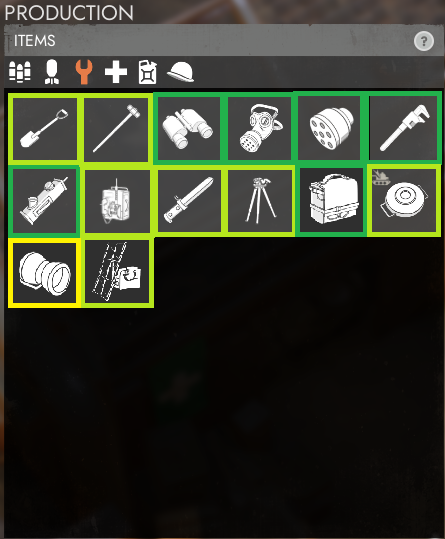


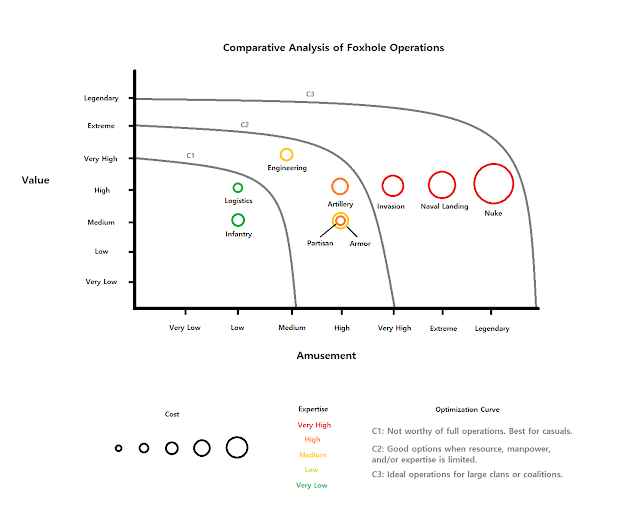
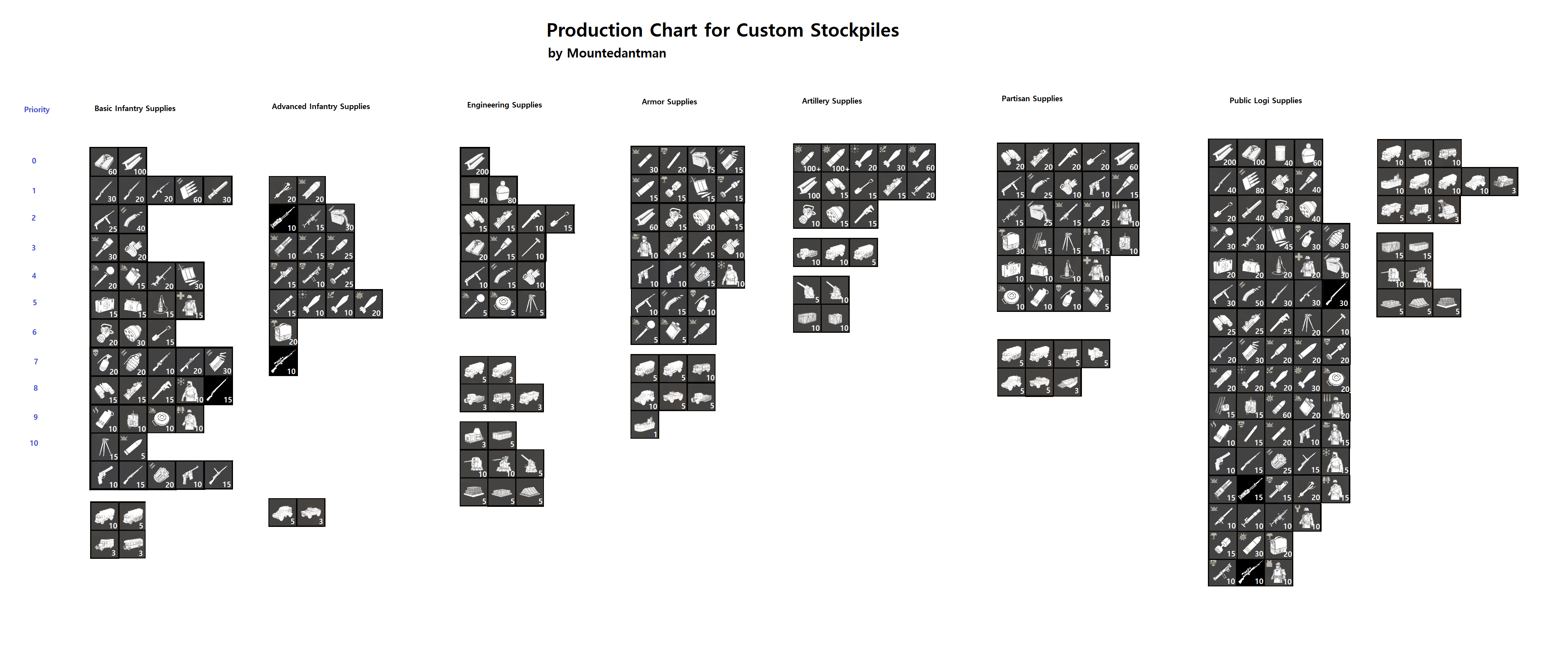

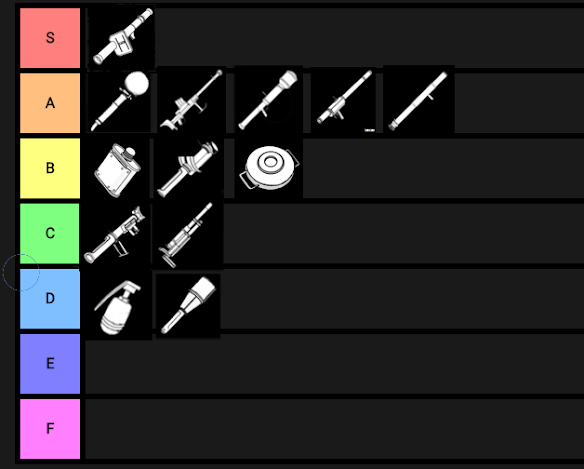
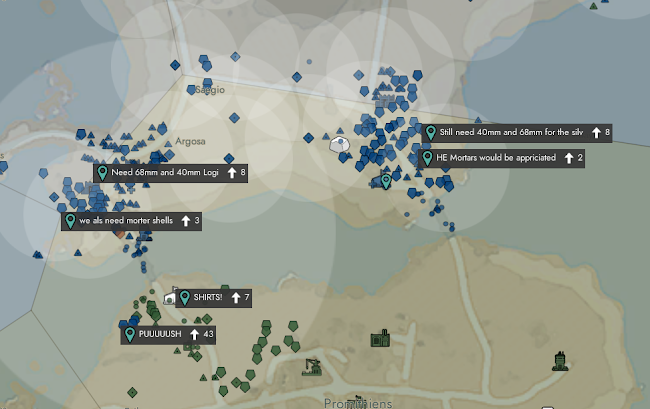

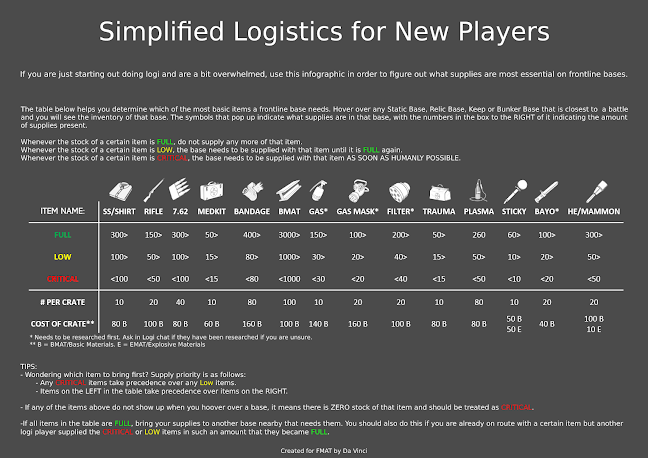
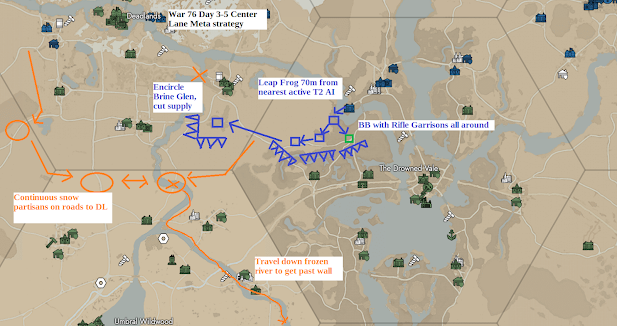
Glorious Guide! Approved by me :D
ReplyDelete